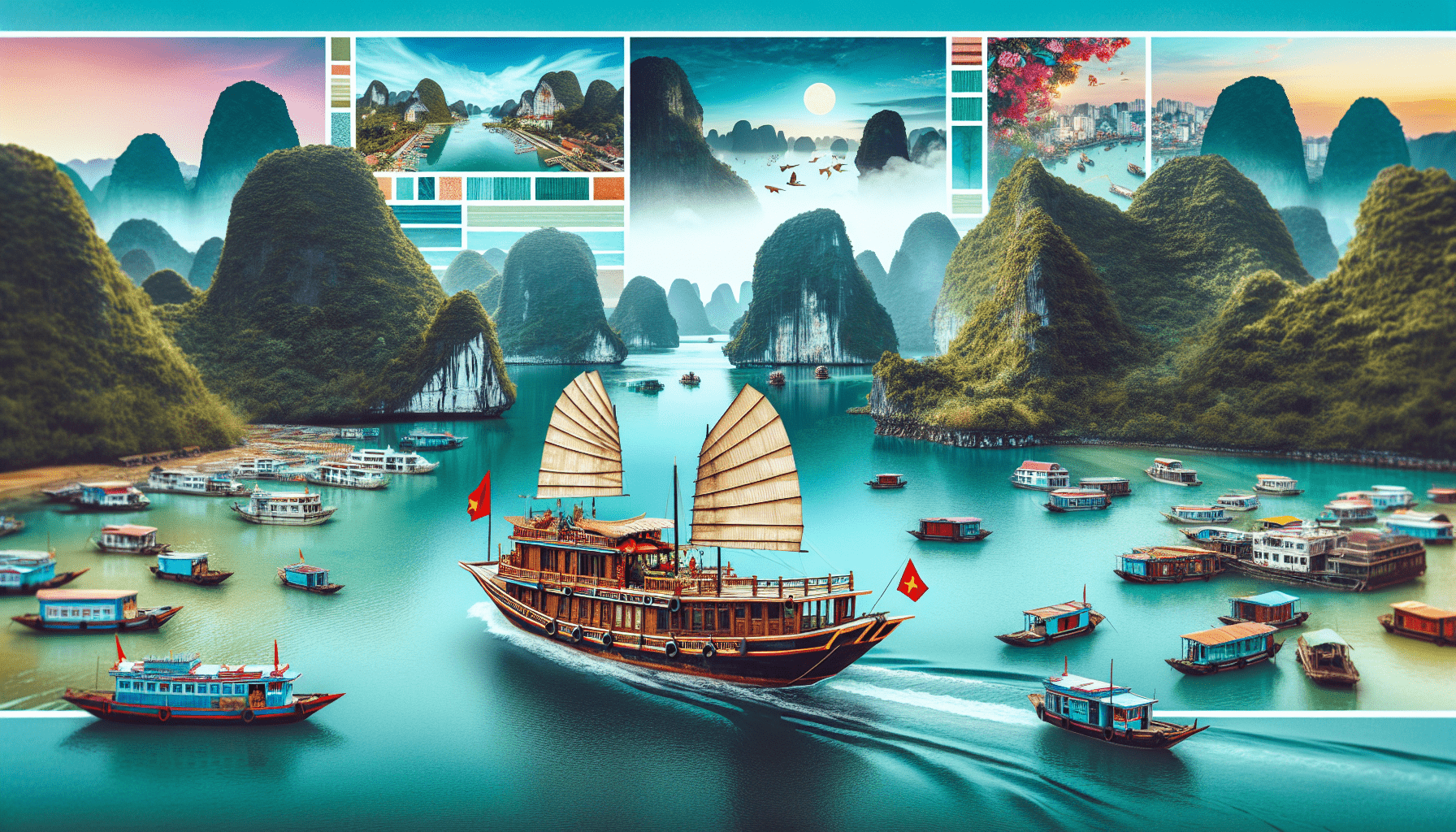
Planning a cruise to Vietnam? Wondering when is the best time to embark on this delightful adventure? Look no further! In this article, we will explore the optimal times to set sail to Vietnam, taking into consideration the weather, festivals, and overall experience that each season offers. Whether you prefer basking under the sun, exploring bustling cities, or immersing yourself in cultural celebrations, we’ve got you covered. So, grab a cup of coffee, sit back, and let’s uncover the best time to cruise to Vietnam.

Climatic Zones in Vietnam
Vietnam is a beautiful and diverse country located in Southeast Asia, known for its rich history, spectacular landscapes, and vibrant culture. The country is divided into three main climatic zones: Northern Vietnam, Central Vietnam, and Southern Vietnam. Each region has its own unique characteristics and weather patterns, making it important to choose the right time to visit based on your preferences and interests.
Summer Season
Northern Vietnam
During the summer season in Northern Vietnam, which extends from May to September, the weather is generally hot and humid. The temperatures can reach up to 35 degrees Celsius (95 degrees Fahrenheit), making it a popular time to visit mountainous regions such as Sapa and Ha Giang. These areas offer breathtaking landscapes, with terraced rice fields and hill tribes that are best explored during this time of the year.
Central Vietnam
In Central Vietnam, the summer season runs from April to August. This region experiences high temperatures and occasional heavy rainfall. However, if you don’t mind the heat, it can be a great time to visit popular destinations like Hoi An and Hue. These cities offer a mix of historical sites, cultural experiences, and stunning beaches, making them ideal for those seeking a diverse vacation.
Southern Vietnam
Southern Vietnam experiences its summer season from February to May, with temperatures averaging around 30 degrees Celsius (86 degrees Fahrenheit). This region is known for its vibrant and bustling cities, such as Ho Chi Minh City, which offer a vibrant mix of history, culture, and culinary delights. The nearby Mekong Delta is also worth exploring during this time, with its lush greenery and floating markets.
Rainy Season
Northern Vietnam
The rainy season in Northern Vietnam lasts from July to September. During this time, the region experiences frequent rain showers and occasional typhoons. While the rain can make traveling more challenging, it also brings lush green landscapes and fewer crowds. If you don’t mind the occasional downpour, this can be a great time to explore the natural beauty of places like Halong Bay and Ninh Binh.
Central Vietnam
Central Vietnam’s rainy season stretches from September to February, with occasional typhoons occurring from October to November. The region experiences heavy rainfall during this time, leading to potential flooding in some areas. However, if you are flexible and prepared for possible disruptions, it can still be an interesting time to visit attractions like the ancient town of Hoi An, where the rain adds to the town’s charm.
Southern Vietnam
The rainy season in Southern Vietnam lasts from May to November, with September being the wettest month. During this time, the region experiences high humidity and frequent afternoon showers. However, the rain usually doesn’t last long, and it can be a good opportunity to take advantage of lower prices and fewer tourists. The popular island of Phu Quoc is a great destination to visit during the rainy season, as it offers stunning beaches and a range of indoor activities.
Winter Season
Northern Vietnam
The winter season in Northern Vietnam spans from November to March, with temperatures dropping to around 10 degrees Celsius (50 degrees Fahrenheit). This region experiences chilly winds and occasional fog, particularly in mountainous areas like Sapa. However, if you are prepared for cooler weather and enjoy a quieter atmosphere, it can be a great time for trekking and exploring the diverse hill tribe cultures.
Central Vietnam
Central Vietnam’s winter season is from December to February, with temperatures ranging from 15 to 25 degrees Celsius (59 to 77 degrees Fahrenheit). The weather during this time is relatively mild and dry, making it a popular choice for beach lovers and outdoor activities. You can enjoy the picturesque beaches of Nha Trang and indulge in water sports like snorkeling and scuba diving.
Southern Vietnam
In Southern Vietnam, the winter season extends from November to April, with temperatures ranging from 25 to 30 degrees Celsius (77 to 86 degrees Fahrenheit). This region experiences less humidity during winter, making it a pleasant time to explore vibrant cities like Ho Chi Minh City and visit popular attractions like the Cu Chi Tunnels. The cool breeze and lower temperatures provide relief from the usual heat of the region.

Spring Season
Northern Vietnam
Spring in Northern Vietnam occurs from March to April, with temperatures rising and flowers blooming. The weather becomes milder and more pleasant, making it a perfect time to explore the capital city of Hanoi and witness the breathtaking beauty of cherry blossoms in full bloom. The countryside also comes alive with vibrant greenery, offering opportunities for peaceful walks and scenic drives.
Central Vietnam
Spring in Central Vietnam, from March to May, brings warmer temperatures and less rainfall. This is an excellent time to explore the ancient town of Hoi An and witness the Lantern Festival, where the streets are adorned with colorful lanterns. The clear skies and pleasant weather make it an ideal time for outdoor activities such as cycling or taking a boat trip along the Thu Bon River.
Southern Vietnam
The spring season in Southern Vietnam lasts from February to April, with temperatures ranging from 30 to 35 degrees Celsius (86 to 95 degrees Fahrenheit). This region experiences a gradual rise in temperatures, accompanied by occasional rain showers. Despite the heat, this time of the year is perfect for exploring the Mekong Delta, with its lush green landscapes and floating markets.
Factors to Consider
When planning your trip to Vietnam, there are several factors to consider, including crowd levels, price and availability, and preferred activities.
Crowd Levels
During peak tourist seasons such as the summer months and major holidays, popular tourist destinations in Vietnam can get crowded, especially in cities like Hanoi, Ho Chi Minh City, and Hoi An. If you prefer a quieter and more peaceful experience, it may be best to visit during the shoulder seasons when tourist numbers are lower.
Price and Availability
Peak tourist seasons often coincide with higher prices and limited availability of accommodations and transport. If you are looking to save money or prefer a wider range of options, consider visiting during the off-peak seasons. You may also be able to find better deals on flights and tours during these times.
Preferred Activities
The best time to visit Vietnam depends on the type of activities you want to do. If you are interested in outdoor activities like trekking, cycling, or exploring national parks, it may be more suitable to visit during the milder seasons when the weather is more favorable. On the other hand, if you are primarily interested in experiencing cultural festivals or enjoying beach activities, the summer and spring seasons may be ideal.
Northern Vietnam Highlights
Northern Vietnam is known for its stunning landscapes and cultural diversity. Here are some highlights of the region:
Halong Bay
Halong Bay is a UNESCO World Heritage Site and one of Vietnam’s most iconic destinations. It features thousands of limestone islands and islets, creating a breathtaking seascape. Taking a cruise or a kayak tour through the bay allows you to explore caves, swim in emerald waters, and witness spectacular sunsets.
Hanoi
The capital city of Vietnam, Hanoi, is a vibrant blend of ancient traditions and modern development. Visit the Old Quarter to explore narrow streets filled with shops, street food vendors, and traditional architecture. Don’t miss must-see sights like the Hoan Kiem Lake and the Temple of Literature.
Sapa
Located in the mountains of Northwest Vietnam, Sapa is famous for its terraced rice fields, ethnic minority communities, and stunning natural scenery. Trekking through the mountains and visiting local villages allows you to discover the unique cultures and traditions of ethnic groups such as the Hmong and Dao.
Central Vietnam Highlights
Central Vietnam boasts a rich heritage, stunning beaches, and vibrant cities. Here are some highlights of the region:
Hoi An
Hoi An is a charming ancient town that effortlessly blends Vietnamese, Chinese, and Japanese influences. Explore the UNESCO-protected Old Town with its well-preserved architecture, colorful lanterns, and narrow streets. Hoi An is also renowned for its tailors, where you can have custom-made clothing within 24 hours.
Hue
Hue, the former imperial capital of Vietnam, offers a glimpse into the country’s history and royal heritage. Explore the citadel, visit ancient temples and pagodas, and take a boat ride along the Perfume River. Hue is a city steeped in culture, and its rich history makes it a must-visit destination.
Nha Trang
Nha Trang is a coastal city known for its beautiful beaches and vibrant nightlife. Relax on pristine white sands, go snorkeling or scuba diving to explore the colorful coral reefs, or enjoy water sports such as jet skiing and parasailing. Nha Trang also offers a range of seafood restaurants and lively bars, ensuring a fun-filled vacation.
Southern Vietnam Highlights
Southern Vietnam is an energetic region that showcases a mix of modern cities, fertile deltas, and stunning islands. Here are some highlights of the region:
Ho Chi Minh City
Ho Chi Minh City, formerly known as Saigon, is Vietnam’s largest and busiest city. Explore iconic landmarks such as the Notre-Dame Cathedral and the War Remnants Museum, shop at bustling markets like Ben Thanh Market, and immerse yourself in the vibrant street food scene. The city offers a blend of history, culture, and modernity.
Mekong Delta
The Mekong Delta is a vast network of rivers and canals that spans across several provinces. Take a boat tour to explore the floating markets, visit fruit orchards, and experience the laid-back lifestyle of the local people. The Mekong Delta is known as Vietnam’s “rice bowl,” and it offers a fascinating insight into the country’s agricultural traditions.
Phu Quoc Island
Phu Quoc Island is a tropical paradise located off the coast of Southern Vietnam. It boasts pristine beaches, lush jungles, and crystal-clear waters. Relax on beaches like Long Beach and Sao Beach, visit the Phu Quoc National Park to discover diverse ecosystems, and indulge in fresh seafood at local restaurants. Phu Quoc is a perfect destination for beach lovers and nature enthusiasts.
Conclusion
Vietnam is a country that offers a wide range of experiences throughout the year, thanks to its diverse climatic zones. Whether you prefer sunny beaches, misty mountains, or bustling cities, there is a perfect time to visit each region. Consider factors such as weather, crowd levels, and preferred activities when planning your trip, and don’t forget to explore the unique highlights of Northern Vietnam, Central Vietnam, and Southern Vietnam. From the stunning Halong Bay to the historical town of Hoi An and the vibrant city of Ho Chi Minh City, Vietnam has something to offer every traveler.



